16 июля 2022
В закладки
Обсудить
Жалоба
По заданию новой демоверсии.
В задании 4 предлагается оставить голосовое сообщение другу, вместе с которым выполняется проектная работа. В этом сообщении надо кратко описать две фотографии-иллюстрации к теме проекта, обосновать выбор фотографии-иллюстрации и выразить своё мнение по теме проектной работы. Максимальное количество баллов за выполнение задания 4 – 10 баллов.
ege_2022_zadanie_4s.docx
ege_2022_zadanie_4s.pdf
Автор: Рома Наугольная (Сень) | vk.com/id30028502
Последнее задание в устной части ЕГЭ, или “обоснование выбора иллюстраций к проектной работе и выражение своего мнения по её проблематике” – еще один “лакомый” кусочек, потому что принесет ученику на экзамене 10 баллов при правильном выполнении. Читайте, как его сдать на максимум 👇🏻
Вот так оно выглядит на экзамене:
Легенда такая, что вы с другом делаете проект по одной из тем, которые обозначены в кодификаторе ЕГЭ, нашли две картинки для иллюстрации и рассказываете ему в голосовом сообщении, почему они такие классные и так пригодятся для вашего проекта.
Кстати, вот эти самые темы из кодификатора:
- Повседневный жизнь и быт, распределение домашних обязанностей в семье. Покупки
- Жизнь в городе и сельской местности. Проблемы села и города.
- Общение в семье и школе, семейные традиции, межличностные отношения с друзьями и знакомыми
- Здоровье и забота о нем, самочувствие, медицинские услуги. Здоровый образ жизни.
- Досуг молодёжи, посещение кружкой, спортивных секций, клубов по интересам. Переписка
- Путешествие по своей стране и за рубежом, осмотр достопримечательностей
- Природа и проблемы экологии
- Современный мир профессий, рынок труда
- Высшая школа и продолжение школьного образования
- Выбор профессии
- Роль иностранного языка в современном мире
- Школьное образование. Изучаемые предметы. Каникулы.
- Новые информационные технологии
- Праздники и знаменательные даты в различных странах
Если вас пугает этот список, то вы можете приобрести книгу по лексике, с которым вы подготовитесь к каждой из этих тем и будете знать, о чем говорить в этом задании и какие выражения для этого использовать.
Готовиться к заданию вы будете 2.5 минуты, а на само говорение отводится 3 минуты. Если вы закончили раньше, то все ок. Главное, чтобы осветила все пункты плана и не наделали ошибок.
Критерии оценивания
Как обычно, вначале посмотрим на критерии из официального документа:
А потом я вам им поясню:
Решение коммуникативной задачи (содержание)
Чтобы получить максимум за этот критерий, нужно:
- Сказать 12-15 фраз, то есть 3-4 фразы на каждый пункт плана. Если вы скажете больше, по делу, правильно и уложитесь во время ответа (3 минуты) – никто вас не накажет. Но если скажете меньше – то увы. 10-11 фраз принесут вам 2 балла по этому критерию, 8 – 9 – 1 балл, до 7 фраз – 0 баллов. А если получите 0 за этот критерий, то и 0 поставят за весь ответ.
- Ученик уложился во время
- Ученик раскрыл все 4 пункта плана:
Организация высказывания
Чтобы получить максимум за этот критерий, нужно:
- Не нарушить логику (то есть, переставлять пункты плана местами)
- Сделать вступление с обращением к другу и сказать заключительную фразу
- Использовать связки-переходы между пунктами плана
- Использовать средства логической связи и не допустить в них ошибки
Теперь дам примеры фраз, которые нужно вставлять в ответ:
Вступление
- Hi Yoda, how are you doing? I have sent you some pictures for our project “…” and I’d like to say a few words about them
- Hi Joker, I’ve found 2 photos for our project and I would like to tell you about them
Краткое описание и различия (1 пункт плана)
- Let me start with describing the pictures. In the first one there is/are … In the other picture you can see …
- Let me describe the pictures for you. The first photo shows … In the second photo one can see …
- I have chosen these pictures because they perfectly illustrate our project …
- These pictures are perfect for our project because they show/illustrate …
- Obviously, there are some differences between the pictures. In the 1st one …, but in the 2nd one …. Apart from that, in the first picture …, whereasin the other picture …
- These photos are quite different. There is/are … in the first picture, while there is/are … in the second one.
- As for the differences in the pictures, one can see that there is/are …
- Talking about the differences, the key difference is that in the 1st picture …, while in the 2nd picture ….
Достоинства (2 пункт плана)
- Now I will discuss the advantages of ….
- The great advantage of … is that …
- As for the advantages, … .
- Talking about …, its advantage is that … .
Недостатки (3 пункт плана)
- Now I will discuss the disadvantages of ….
- One of the key disadvantages of … is …
- As for the disadvantages, … .
- Talking about …, its drawback is that … .
Мнение (4 пункт плана)
- Personally, I … because …
- In my opinion, … The main reason for this is the fact that …
- As for me, I … because …
- In conclusion, I would like to say that I consider …
Заключение
- That’s all for now. Tell me your opinion about the pictures!
- That’s it. Please, tell me what you think about these photos.
- That’s all from me now, Please, get in touch with me and say what you think about the photos.
То есть, план ответа должен выглядеть вот так:
- introduction
- give a brief description of the photos (connected with the topic) + note the differences (2 черты – мой личный совет)
- mention the advantages (2 пункта – мой личный совет)
- mention the disadvantages (2 пункта – мой личный совет)
- express your opinion on the subject of the project – which … you prefer and why (тема написана в задании)
- conclusion
А ученикам предлагаю вот такой ☠️ “скелет” ☠️ высказывания:
- Hi Yoda, how are you doing? I have sent you some photos for our project “NAME” and I’d like to say a few words about them.
- Let me describe them for you. In the first picture one can see … . There is/are … in the second picture. Talking about the differences, the key difference is that in the 1st picture …, while in the 2nd picture ….
- I believe that … presented in the pictures have their advantages and disadvantages.
- As for the advantages of …, I would name ….
- Talking about the disadvantages of …
- Personally, I … The main reason for this is the fact that …
- That’s all from me now. Please, get in touch with me and tell me what you think about these photos.
Языковое оформление высказывания
Чтобы получить максимум за этот критерий, нужно:
- Допустить не больше 3-ех НЕгрубых лексико-грамматических ошибок или 3-ех НЕгрубых фонетческих ошибок
Чтобы понять, что за НЕгрубая ошибка такая, дадим определение обратному термину. Грубая ошибка – ошибка, искажающая понимание высказывания – отсутствие согласования подлежащего и сказуемого (they am/ he have), неправильная постановка артикля (in background/ we see a people), употребление Present Simple при описании картинки, ошибка в элементарной лексике (dress вместо wear, watch вместо look at, beer вместо bear), произношение слова thing /θɪŋ/ как /sɪŋ/. По-простому, это грамматика, лексика и произношение слов, которые все знают уже на уровне Pre-Intermediate.
Пример ответа
А теперь, используя мою схему, приведу образец ответа на это задание:
- Hi Yoda, how are you doing? I have sent you some photos for our project “Shopping” and I’d like to say a few words about them.
- Let me describe them for you. In the first picture one can see a happy family standing in the aisle of a supermarket. They’ve got a basket full of groceries in front of them. There is a woman sitting at home in front of her laptop in the second picture. She’s holding a credit card and smiling. Talking about the differences, the key difference is that in the 1st picture the family is shopping in a supermarket, while in the 2nd picture the woman is shopping online.
- I believe that the two types of shopping presented in the pictures have their advantages and disadvantages. As for offline shopping, its biggest advantage is that you can spend quality time with your family while going around the supermarket shopping for groceries. Talking about online shopping, one of its advantages is that you don’t have to carry heavy bags home as you can get your groceries delivered home.
- Now I will discuss the disadvantages of the two types of shopping. Offline shopping can be quite time-consuming as you have to spend time on the way to the shop and back home. While shopping online, if you are not careful enough your credit card details might be stolen and you can lose your money.
- Personally, I prefer online shopping because I hate going to regular shops. I dislike these crowds of people that fight for discounts and their place in the queues. When I shop online, there’s only me in the room so I do not suffer from any stress.
- That’s all from me now. Please, get intouch with me and tell me what you think about these photos.
(25 фраз)
У меня получилось прям высказывание высокого уровня. На экзамене вы можете говорить с использованием сложных грамматических структур и лексики, а можете – незаковыристо. Если соблюли все критерии и не сделали ошибок, ответ будет оценен на максимальный балл.
Основные ошибки
Теперь про основные “ляпы” учеников в этом задании.
В содержании:
- забывают вступление и заключение
- говорят не 2 черты отличий фото, и теряют по кол-ву фраз в ответе
- говорят мало фраз
- повторяют идеи в разных пунктах и грамматические структуры с лексикой
- забывают, что нужно назвать тему проекта, которая написана в задании (в нашем задании – “shopping”
- не используют подсказку из 2-го и 3-го пункта задания с advantages/disadvantages (в нашем примере – “the two types of shopping”)
- забывают, что в пункте 4 у нас уже написана проблема, по которой нужно высказать мнение, и придумывают свою и/или используют другую формулировку (например, в задании написано “prefer”, а говорят “would prefer”, например в нашем задании нужно сказать – “prefer offline/online shopping”)
- не укладываются во время и ученикам минусуют пункты, которые остались за пределами 3 минут высказывания
Последний пункт – прям типичное слабое место всех ЕГЭшников. Они очень долго не могут придумать, что сказать и как не повториться в идеях, и в итоге теряют время на записи ответа. Чтобы этого избежать, на первом этапе тренировки придерживаемся такого алгоритма подготовки: -> brainstorm карточки – прописываем ответ на это задание -> отчитываем -> заучиваем -> тренируемся с диктофоном. Если не получилось уложиться в 3 минуты, повторяем тренировку с диктофоном, пока не натренируем намертво.
Когда ученики запомнили схему ответа, уже ничего не записываем, тренируемся вживую на уроках. Если проблема повторяется, “долбим” проблемное задание, пока не получится уместить свой красивый ответ в эти ненавистные уже 3 минуты.
Некоторые репетиторы говорят, что начинают тренировать устную часть за 2 месяца до экзамена, чтобы не тратить на неё время в течение года. Я так не делаю, даже с учениками, с которыми занимаюсь больше, чем 9 месяцев до ЕГЭ. В моей практике надо хотя бы начинать её тренировать за полгода, пусть не очень усиленно, но нужно. Подкреплю примером. Недавно готовила к ЕГЭ девочку, с которой занималась 4-е года. В 2018 она сдала ОГЭ по английскому, потом экстернатом заканчивала 11 класс и сдавала ЕГЭ. Устную часть она не могла сделать мне на максимум около 3-ех месяцев.
В грамматике:
- Используют Present Simple при описании того, что видят на фотографии – The children hold presents
- Ставят неправильный предлог в словосочетании “in the picture/ photo” – there’s a family on/at the picture/ photo
- Забывают артикли – “there is boy in the photo” или ставят неправильные. Например, первый раз сказали про этого мальчика “a boy”, и продолжают про него говорить с неопределенным артиклем, хотя второй раз нужно говорить “the boy”
- Забывают окончание -s – “the photo show us children in the park”, или ставят его туда, где не нужно – “both pictures shows us …”
Нужно замечать, какие ошибки у ученика любимые и заставлять его контролировать себя. Можно задавать ему на дом сравнивать картинки, записывать себя на микрофон, слушать и отслеживать ошибки. Ну и вместе разбирать их на уроке.
На мой взгляд, задание совсем несложное, нужно просто выучить план ответа и хорошо его оттренировать.
Еще не забываем, что на экзамене вместе с учеником начнут сразу говорить еще несколько человек, которые сидят в компьютерном классе. Поэтому на занятиях полезно включать радио, или телевизор, когда ученик делает устную часть. Помогает справляться с звуковыми помехами на экзамене.
И еще
Пока не выпустили адекватных пособий для подготовки к этой части экзамена (кроме моей книги по устной части) И так как ФИПИ совсем недавно утвердило эту демоверсию, в интернете вы можете найти много неточной информации по этому заданию и фейков. Помните, самая точная информация – ТОЛЬКО НА ФИПИ.
Кстати, у эксперта на экзамене будет вот такая схема оценивания. Очень удобно!
Если вы этого еще не сделали – покупайте план ЕГЭ, который помог более 1.000 преподавателей по английскому подготовить своих учеников на высокие баллы
P.S. Про разделы и стратегии выполнения заданий ЕГЭ можно еще почитать:
Аудирование, задания 1 — 9
Чтение, задания 10 — 18
Грамматика, задания 19 — 25
Словообразование, задания 26 — 31
Лексика, задания 32 — 38
Личное письмо, задание 39
Проект, задание 40
Устная часть, задание 1
Устная часть, задание 2
Устная часть, задание 3
ELTgram от Ирины Кузнецовой
Поможем в ✍️ написании учебной работы
Text. Higher education in our country and my University
Higher education plays an important part in the life of our country as it provides the country with highly-qualified specialists. Higher education in this country is accessible to all. The greater part of students study free of charge, some – on a commercial basis.
The academic year usually lasts 9 months and is divided into two terms. At the end of each semester students take exams. If the results are good students get grants. Twice a year students have vacations – two weeks in winter and two months in summer.
The first and second-year students obtain thorough information in the fundamental sciences. The curriculum is enriched and broadened by such subjects as foreign languages, history and economics.
At the third year students get more advanced knowledge and begin to concentrate on their “major” subjects.
In senior years theory is accompanied by practical training.
After four years they will get a Bachelor’s degree. Then the students may go on with their studies and in a year or two of further study and research get a Master’s degree. After graduating they may continue research and get a still higher degree.
As for me, I study at the Russian State Vocational Pedagogic University. It was founded in 1979. At first it was called the Sverdlovsk Engineer Pedagogic Institute. Not long ago it was given the Russian status. The structure of our university includes different departments (full time and correspondence). Each department has a number of faculties. I study at the faculty of . . . . I’m a full time student.
My university has several buildings, old and new ones. There are many various laboratories, a good library and a computer center in the main building.
Words and phrases to remember:
to study free of charge/on a commercial basis – бесплатно/платно
to take exams – сдавать экзамены
to get a grant – получать стипендию
to obtain thorough information in – получать подробную информацию по
to be enriched – быть обогащенным
to be broadened – быть расширенным
to be accessible – быть доступным
to get advanced knowledge – получать углубленные знания
to graduate – закончить вуз
to continue research – продолжить исследование
a full time/correspondence department – дневное/заочное
a curriculum — расписание
Answer the questions:
1. What is the aim of higher education in our country?
2. Is it accessible for all?
3. Do the students study all free of charge?
4. What can be said about the academic year?
5. What are the stages of education?
6. What university do you study at?
7. When was it founded?
8. What was it called at first?
9. When was it given the Russian status?
10. What is the structure of our university?
11. What faculty do you study at?
13. Do you enjoy studying at this university?
Ex. 1. Translate from Russian into English.
1. Сейчас есть институты, где все учатся на коммерческой основе.
2. Многие студенты не получают стипендию, так как они учатся плохо.
3. В конце каждого семестра мы сдаем экзамены.
4. На первом и втором курсах они получают подробные сведения из области фундаментальных наук.
5. Наша еда должна быть обогащена минералами.
6. Эта дорога должна быть расширена.
7. На старших курсах они получают углубленные знания по предметам.
8. После окончания института можно продолжить исследования.
9. Мой друг – студент заочного отделения.
Ex. 2. Be ready to speak about our system of education and your university.
Литература
1. Орловская И. В., Самсонова А.С.. Учебник английского языка для студентов технических университетов и вузов. М.: Изд-во МГТУ им. Н. Э. Баумана, 2000.
2. Коваленко П. И. Английский для психологов. Ростов-н/Д: Феникс, 2000.
3. Ежова Т. С. Учебно-методическое пособие по английскому языку. Екатеринбург: Изд-во УГТУ-УПИ, 1998.
4. Филатов А. В. Курс страноведения. Екатеринбург: Изд-во Урал. гос. пед. ун-та, 1996.
Методические указания по самостоятельной работе студентов
(английский язык)
Для студентов всех специальностей

Подписано в печать 27.02.2003. Формат 60´84/16. Бумага для множ. аппаратов. Печать плоская. Усл. печ. л. 1,6. Уч.-изд. л.1,7. Тираж 3000 экз. Заказ № 120.
Российский государственный профессионально-педагогический университет. Екатеринбург, ул. Машиностроителей, 11.[H1]
Ризограф РГППУ. Екатеринбург, ул. Машиностроителей, 11.
[H1]
История  Education in Russia
Education in Russia
просмотров — 1119
HIGHER EDUCATION
Specific character of modern life makes high demands of all our people, their inner world and their professional skills which are mainly determined by the level of their education.
In our state all its people have the right to education which is guaranteed by the Constitution of the Russian Federation. Having got their secondary education in schools, lyceums or gymnasiums, they can enter any higher educational establishment.
The national system of higher education offers various forms of training specialists: full-time, part-time, extra-mural or correspondence and sandwich-course. Admission is both by the results of the entrance competitive examinations and the Uniform Graduation Examination.
In the Russian Federation there are over 2 200 higher educational institutions, including both public and non-public or commercial higher schools. They are divided into the following main types:
1) Arts and technical universities, academies, institutes and colleges which offer a wide range of disciplines.
2) Specialized educational institutions which concentrate on specific fields of knowledge.
Russia ranks now among the top 10 countries in the world according to the ratio of its students to the total amount of its population.
The Russian higher education is considered to be one of the best in the world due to:
1) High standard of education.
2) Solid theoretical base.
3) Stimulation of innovative processes by combining theoretical disciplines with scientific research.
4) Leading role in humanities and applied sciences.
5) Competitiveness of the Russian diplomas.
6) Cheaper fees compared to those in foreign universities and colleges.
The Russian graduates are today in great demand both at home and abroad. For example, thousands of the Russian graduates hold the highest posts and successfully work now in the Silicon Valley, the USA, in the field of new computer technologies.
Keeping to the best national traditions, the national system of higher education is being constantly modernized. Today Russia needs highly skilled and creative specialists, who not only meet the demands of science, up-to-date production and culture, but are capable to foresee the prospects of their further development.
That’s why one of the most important educational objectives for today is to keep the high standard of the Russian education and increase our scientific potential to be highly competitive in the world.
Russia’s oldest University
The State University of Moscow is one of the oldest in Russia. It was founded by the Decree of the Russian Empress Elizabeth on the 25-th of January 1755. From that time this day is celebrated as Students’ Day in our country.
The University was named after its founder, the greatest Russian scientist Michael Lomonosov. At the very beginning there were only 3 faculties at the University: law, medicine and philosophy. Following the best traditions of the Russian education laid by Michael Lomonosov, the university became one of the best educational institutions both at home and abroad.
Nowadays the University of Moscow is the pride of our country. It ranks among the leading higher educational establishments of Europe and is one of the most prestigious universities in the world.
Currently, the University comprises 26 faculties and 17 research institutes and centers which offer the following programs:
1) ВА/ BSc (Bachelor of Arts/Bachelor of Science),
2) МА/ MSc (Master of Arts/Master of Science),
3) PhD/ ScD (Doctor of Philosophy/Doctor of Science).
It also has one of the country leading institutes for retraining and upgrading the teachers’ skills.
Among its 9000 professors, teachers and researchers there are 125 Academicians of the Russian Academy of Sciences, 7000 holders of PhD or ScD Degrees and several Nobel Prize Winners. More than 50% of its researchers are involved in teaching.
Today the University enrolls over 28 000 students, about 5000 postgraduates and more than 1 500 foreign students from almost 100 countries of the world. Specialists’ training is carried on within 500 curriculums in scientific, theoretical and applied aspects.
The academic year consists of 2 semesters. It starts in September and is over in June. Each semester the students take their terminals and exams.
The University library is one of the largest in the country. It has almost 9 million academic and scientific publications as well as one of the biggest and unique collections of manuscripts and rare books.
The students’ life is full of various activities both during the term time and at vacations. At the students’ disposal there are over 30 various sport sections, vocal and organ classes, students’ theatre, dancing and opera studios, recreation centre and cinema, chamber orchestra and several museums.
A distinctive feature of the M. Lomonosov State University work is combining its academic work with extensive research. The University is closely cooperating with the leading international organizations and major educational centers of various countries.
Читайте также
А) Выберите нужную форму глагола из приведенных в скобках.
My name (is, was, am) Victor Sedov. I (is, am, was) seventeen years old. I (is, was?am) a first-year student of the mining college. Our college (is, are, was) in thе centre of the town.
I (have, has, had) a lot of friends at the college. After the course of studies we (shall, will,are going to become mining engineers.
My grandfather (were, was, will be) a mining engineer too. He… [читать подробенее]
Тема 3. Медицинское образование в России
The Dialogue
Задание 1. Прослушайте диалог. Воспроизведите его в парах:
A Talk between Two Students
B. – I want to introduce myself. I’m Boris and what’s your name?
S. – My name is Sergei. Glad to meet you. Are you a student?
B. – Yes, I am. I’m a first-year student of the Stavropol State Medical Academy, and what about you?
S. – I’m a… [читать подробенее]
All establishments of higher medical education are financed and guided by the Ministry of Health and Social Development of the Russian Federation.
Doctors of different specialties are trained at medical institutions of higher education, at medical universities and academies. There are also pharmaceutical academies, which train specialists in pharmacy.
Medical institutions of higher education offer various faculties and specialties which an entrant may choose according to his or her abilities… [читать подробенее]
IV. READING
III. SPEAKING
Упражнение 1. Ответьте письменно на вопросы о Вашей учебе, используя слова и выражения из предыдущей части.
1. What is your name?
2. Where do you study?
3. When did you enter the University?
4. What year student are you?
5. Which department do you study at?
6. What is your speciality?
7. How often do you have lectures and practical classes?
8. When do your… [читать подробенее]
D) Prepare a 3-minute talk on one of the great teachers of the past or today, give reasons for your choice.
EXERCISES
I. a) Transcribe and learn to read the following words:
machines, appreciate, humanity, vital, challenge, individual, awareness, ignorance, fearful, boredom, medium, accept, routine, stimulating, variety.
b) Study Texts A and В and explain the meaning of the words and word combinations listed below:
think privately, the most vital job, a rewarding, job, a… [читать подробенее]
HIGHER EDUCATION
Specific character of modern life makes high demands of all our people, their inner world and their professional skills which are mainly determined by the level of their education.
In our state all its people have the right to education which is guaranteed by the Constitution of the Russian Federation. Having got their secondary education in schools, lyceums or gymnasiums, they can enter any higher educational establishment.
The national system of higher education… [читать подробенее]
Диаграмма междисциплинарного пособия по английскому языку
В формируемое таким образом единое поле профессиональных знаний и умений магистрантов входят указанные когнитивные компоненты, развивающиеся на основе иностранного языка. Отметим также, что если… [читать подробенее]
Диаграмма междисциплинарного пособия по английскому языку
В формируемое таким образом единое поле профессиональных знаний и умений магистрантов входят указанные когнитивные компоненты, развивающиеся на основе иностранного языка. Отметим также, что если… [читать подробенее]
Диаграмма междисциплинарного пособия по английскому языку
В формируемое таким образом единое поле профессиональных знаний и умений магистрантов входят указанные когнитивные компоненты, развивающиеся на основе иностранного языка. Отметим также, что если… [читать подробенее]
Read the following text and answer the questions.
In the contemporary world the importance of human capital as a significant contributor to national wealth suggests that the education system is evaluated as a meaningful factor in the development of the quality and quantity of economic and social growth. The Russian system of education is considered by many, both inside and outside of Russia, to be the best education system in the world. Unfortunately some aspects of education in Russia are… [читать подробенее]
Слайд 1
Описание слайда:
Education in Russia
Слайд 2
Описание слайда:
The structure of education in Russia
The education system in our country includes a number of links: 1 Preschool education 2- School 3- vocational 4- technical secondary special higher education 5- 6- 7- postgraduate education system and retraining of personnel, interest education.
Слайд 3
Слайд 4
Описание слайда:
School education = general education.
School education — the ability to master the elementary level of scientific knowledge necessary for the understanding of the basic phenomena of nature and society.
Designed to address three fundamental to society and the individual tasks:
Слайд 5
Описание слайда:
2- Giving young people a basic knowledge for a smooth transition to work or professional self-determination.
3- To provide vocational guidance of young people.
Слайд 6
Описание слайда:
3 stages of school education.
1 Primary School
2 Primary school
3 — High School
As the case studies and statistics, modern secondary school is not fully meeting its objectives: increasing the level of deviant behavior of underage youth, including crime, alcoholism, drug addiction, etc. The school does not fully solve the problem of professional self-determination.
Слайд 7
Описание слайда:
High education
From the history of higher education.
In 1987 in the USSR was 896 higher education institutions. According to the Federal State Statistics Service in Russia in 2008/09, there were 1,134 public and private universities. But in the Soviet era, nearly 900 high schools accounted for 280 million. People, and today (do not forget about the hundreds of private higher institutions of researchers) — 145 million. People.
Number of schools in recent years has dramatically increased primarily due to the non-state universities and branches of government, and this requires close attention to the evaluation and control of the quality of education.
Слайд 8
Описание слайда:
The total enrollment of students in public higher education institutions for the enlarged group of specialties
1 Engineering — engineering — 31%
2- Economic — 26%
3 Humanities — 19%
4- Teaching — 8%
5- course — scientific — 6%
6- Medical — 3%
7- Farm — 4%
8 of culture and art — 2%
Слайд 9
Описание слайда:
Higher education — the opportunity to receive educational services of the highest caliber and quality professional education.
Depending on the number of areas of training students in modern Russia there are the following types of institutions: universities, academies and institutes.
Training is carried out in them full-time, part-time, part — time (evening) form and in the form of external studies.
University graduates may have the qualifications: Bachelor’s degree, graduate, master’s degree in the relevant areas
Слайд 10
Описание слайда:
The dependence of the number of students by level of education
Слайд 11
Слайд 12
Описание слайда:
The state’s role in the Russian education
State in relation to the Institute of Education, in the case of present-day Russia, performs three functions.
Regulatory authority for the whole of the education system as a whole.
-Uchreditelya Or owner of various levels and components of the educational system.
— Managing the territorial entities, responsible for the integrity of the educational systems.
Слайд 13
Описание слайда:
The project «Education»
The national project «Education» is designed to introduce systemic changes in education. Need to develop new approaches for the realization of the planned changes, identify and support the leaders who will implement these changes in practice.
Experts identify four main objectives of the project:
1- systemic changes in Russian education.
2- development of civil society institutions.
3- formation of modern management in the education system.
4- support leaders
Слайд 14
Описание слайда:
«Education» project consists of several areas
Promote innovative programs and higher professional education (in particular, the selection among the existing 30 innovative universities, handing each of them a grant of up to 500 mln. Rubles .; Definition 6 th. Of innovative schools with the award of each grant of $ 1 million., Rubles)
The creation of new universities and business — schools (two national universities — in the Southern and Siberian Federal Districts, two business — schools — in the Moscow region and St. Petersburg)
Слайд 15
Описание слайда:
The ratio of youth to education.
Studies have shown that Russian schoolchildren adolescence, first, perceive the school as hanging out with friends, and not as a place where one learns. Many tasks are performed only because this is required by teachers and parents monitor evaluation. Second, students do not see the connection between school and their future life.
Слайд 16
Описание слайда:
Informatization of education (in particular internet connection 20 th., Schools, development and the introduction of distance learning programs) support the initiative, capable, talented youth (promoting a one-time award of $ 60 thousand., Rubles. 2500 man-talented children and youth) . development of vocational training in the army (in particular, the creation of 100 training centers in parts of the Russian army). additional remuneration for classroom management in high school (class teachers supplement of complete classes 1 ths., rub. per person per month, a total of about 900 thousand. man). Promotion of the best teachers in the amount of 100 thousand., Rubles., 10 thousand of the best teachers each year.
Слайд 17
Описание слайда:
Choice of high school graduates of schools — is not only the choice of place of study, and professional self-determination, recognition of the priority of a certain lifestyle. According to the survey, the motives of receipt in high school is as follows:
— To engage in intellectual work in the future — 56%
Get profession in accordance with the inclination — 24%
— At the insistence of parents — 9%
— Not called up — 6%
— Nowhere to go after school — 5%
Слайд 18
Описание слайда:
Answer the questions
1- Describe the structure of education in our country? Justify your opinion.
2- What is the role in the formation of the Russian state?
3 Compare the main tasks and higher education?
4- What is the national project «Education»?
Слайд 1Higher education in Russia
Prepared Shevtsov Artem
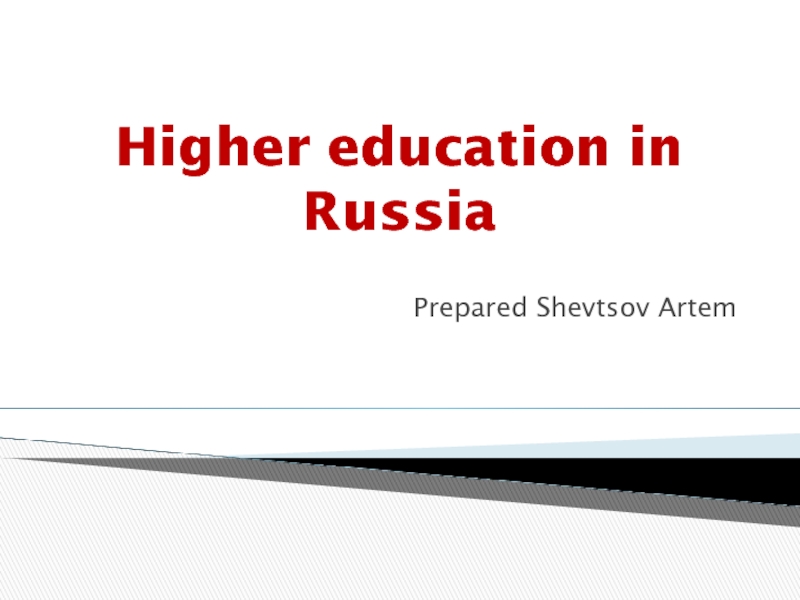
Слайд 2Levels of education
OVERALL
PROFESSIONAL
— the education that the student receives:
primary (primary classes);
basic
(up to grade 9);
average (full) (for 11th grade).
— education that allows you to gain professional knowledge:
primary vocational (vocational schools, lyceums);
secondary vocational (technical schools, colleges);
higher professional (academies, universities, institutes).
–
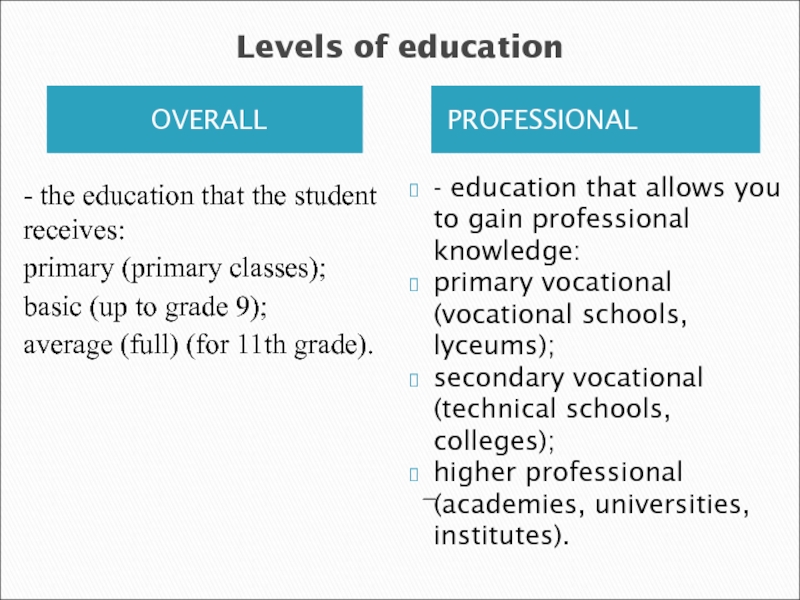
Слайд 3The University covers a wide range of specialties from different areas
(no less than 7 areas).
The Academy is distinguished by a narrower range of specialties (for one branch of the economy). Any of these two statuses are assigned to an educational institution, provided that extensive scientific research is carried out at a certain level.
The INSTITUTE trains at least one specialty and conducts scientific activity on its own
discretion.
Types of higher education institutions
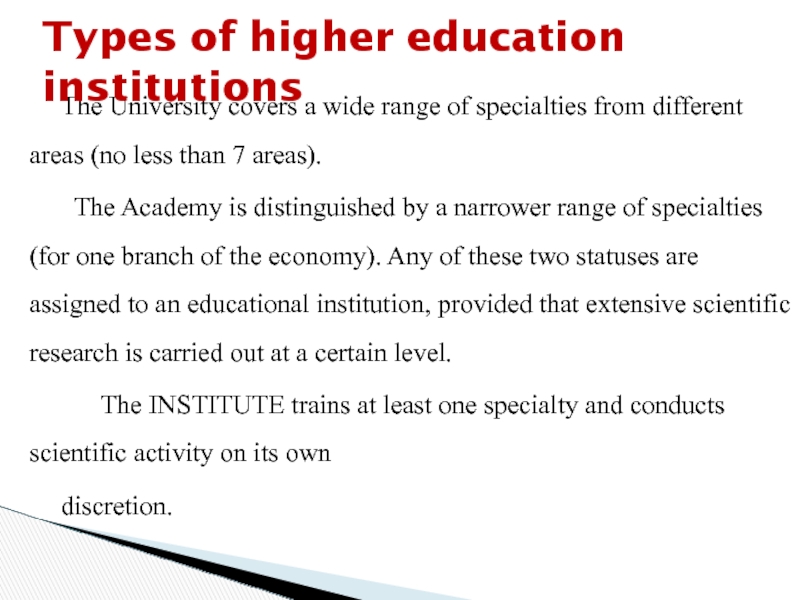
Слайд 4In Russia, the first institution — a teacher’s institute — was
founded in 1802-1804 at the St. Petersburg University.
Branch of the Non-State Educational Private Institution of Higher Professional Education «St. Petersburg Institute of Management and Law»
ul. Zelinsky, 30, School No. 24, fl. 4
The Institute
2014

Слайд 5owned by the mythical hero of Academ, in which the philosopher
Plato taught his doctrine in 388 BC.
In Russia, one of the first was the Slavic-Greek-Latin Academy, which opened in 1658.
Academy of Arts — the first secular academy, founded in 1757.
Academy
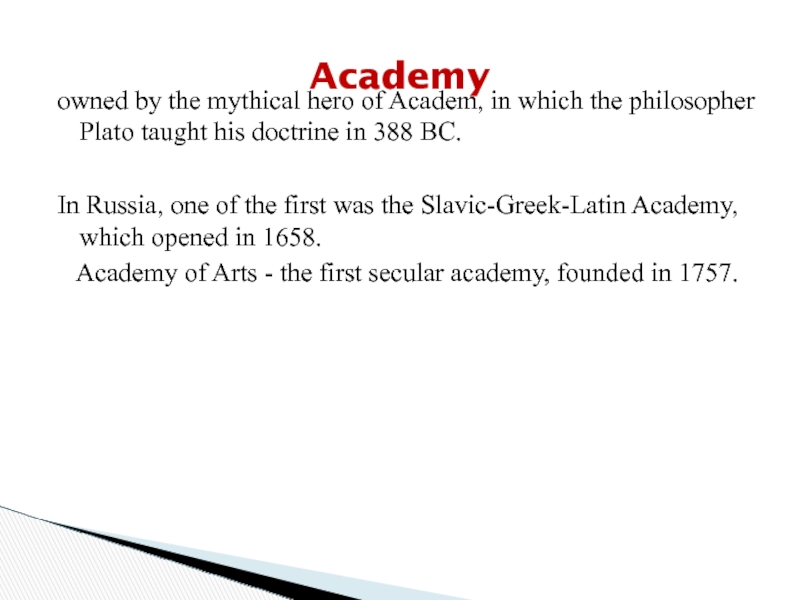
Слайд 6
daily (full-time);
evening (full-time);
extramural;
remote;
eksternat.
Forms of training
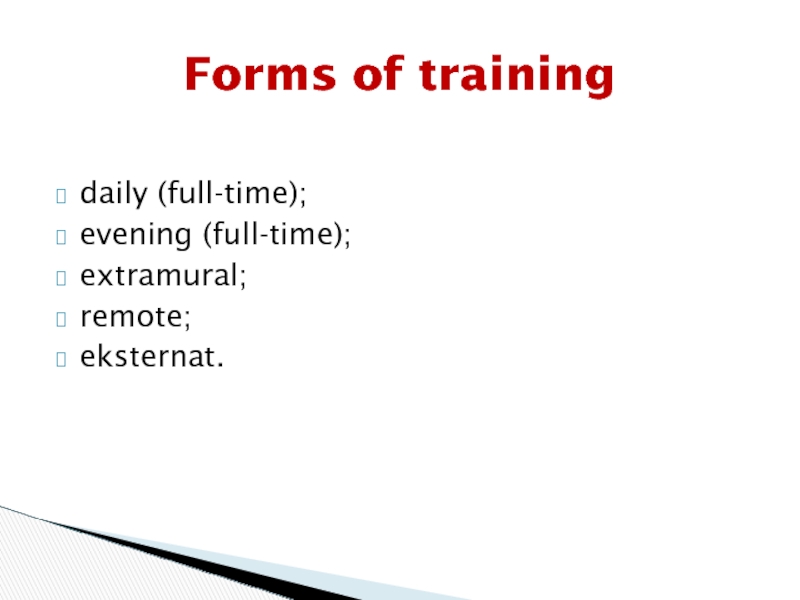
Слайд 7Traditional and widespread form of education.
Having chosen this method of
higher education, the student must attend lectures and seminars, and after the semester take exams.
Full-time education

Слайд 8Another name is the evening one.
It gives an opportunity to get
higher education without stopping work.
Classes in this form are held in the evening or on weekends, and in the afternoon the student can work.
Part-time study
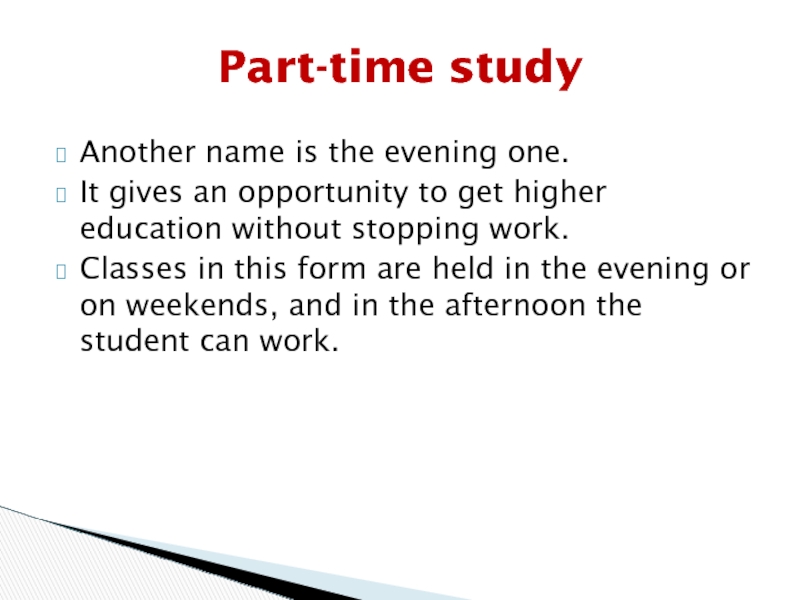
Слайд 9Assumes a sufficiently large degree of self-study.
The correspondence form is usually
divided into two phases:
an installation session, when a student is provided with a list of necessary for self-teaching literature,
test-examination session, when teachers in full-time form check the students’ acquired material.
Usually the phases are significantly spaced in time, and examinations are held twice a year — in winter and in summer.
Extramural studies
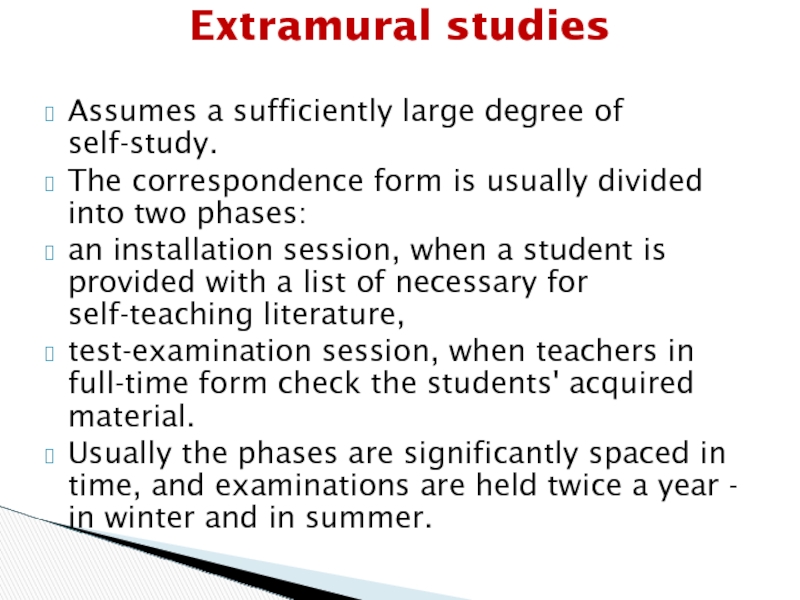
Слайд 10It assumes delivery of the studied material to students and their
remote communication with teachers using Internet services.
The students themselves choose the time for independent work, and with the questions that arise, they can turn to the teacher.
With distance education, you can get an education in another city without leaving home.
Distance Learning Form
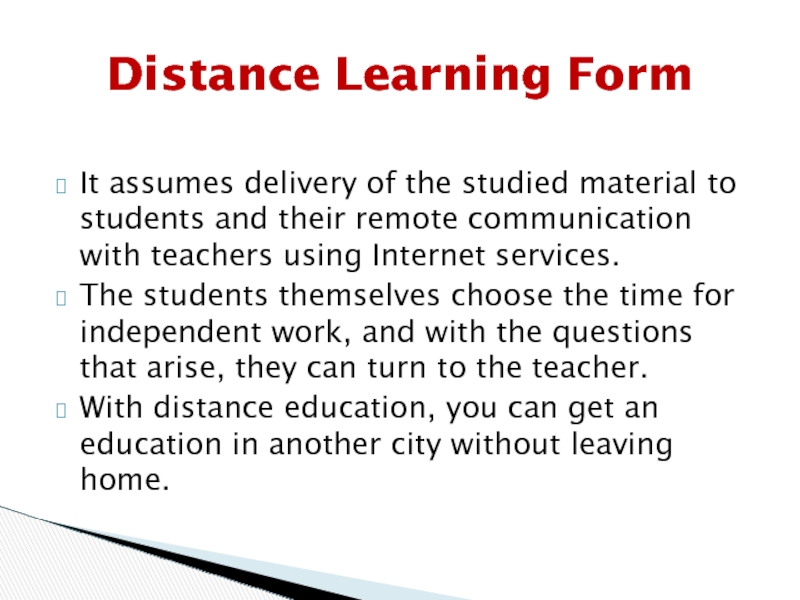
Слайд 11put 5 please (or at least 4)
Thank you for attention
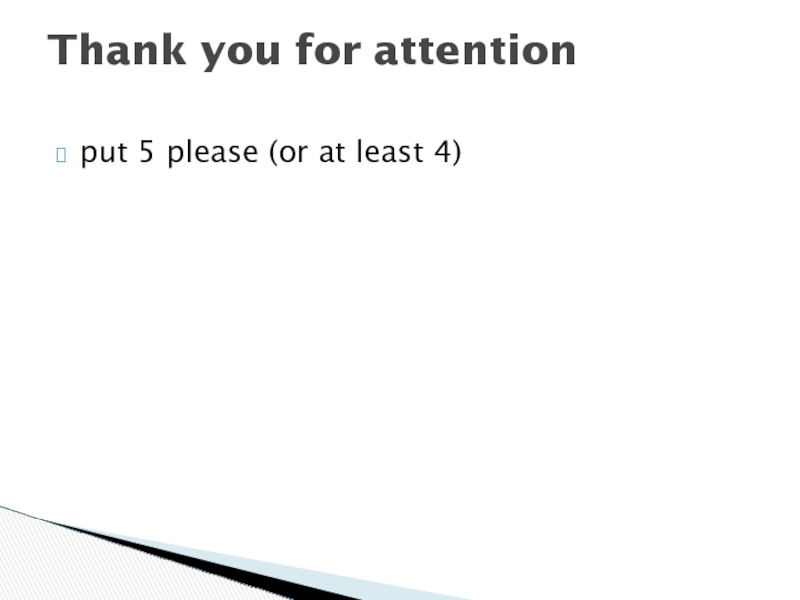
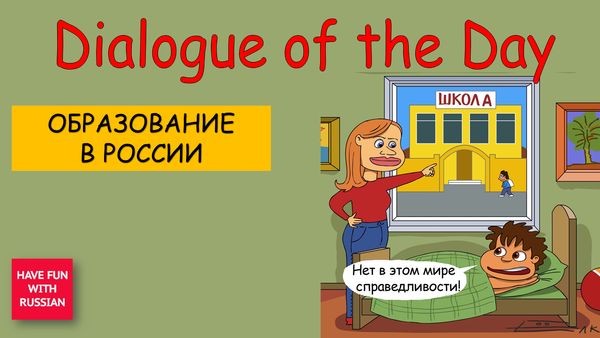
|
Образование в России |
Education in Russia |
|
За последние 20 лет Россия очень сильно изменилась. Изменилась и система образования. Сейчас появились частные школы и детские сады, а также негосударственные колледжи и университеты. Если родители работают, то ребёнка отдают в детский сад с восьми утра до пяти вечера. Плата за государственный детский сад – символическая, но это не значит, что такой детский сад хуже частного. |
Russia has dramatically changed for the last 20 years. Education has also changed. There have been a lot of private schools and kindergartens, colleges and universities. If parents work, a child goes to kindergarten for the whole day from 8 a.m. to 5 p.m. Charges for a state kindergarten are symbolic, but it doesn’t mean that a state kindergarten is worse than a private one. |
|
В школу дети идут с шести лет. Школьное образование бесплатное. Есть спортивные школы, художественные, математические, школы с углублённым изучением иностранных языков, музыкальные школы. Каких только школ нет! |
Children go to school at the age of 6. School education is free. There are a lot of special schools — Sport, Art, Math, Foreign Languages, Music, you name it! |
| После окончания обычной общеобразовательной школы можно поступать в университет. Для этого нужно успешно сдать ЕГЭ – Единый Государственный Экзамен. Но некоторые университеты, например МГУ – Московский Государственный университет, — проводят дополнительные вступительные испытания, а также Олимпиады, победители которых могут учиться в университете бесплатно и даже получать стипендию. Остальные студенты платят от 30 тысяч до 150 тысяч рублей за семестр, что немногим под силу. |
Having graduated from a high school, you can go to a university. You have to pass the Unified State Exam. But some universities including MSU, for example, hold an additional entering test as well as competitions (Olympiads), the winners of which can learn at the university free, and even receive a scholarship. All the rest have to pay from 30 thousand to 150 thousand rubles for a semester, that not many people are able to do/can afford it. |
| Сейчас Майкл и Анна находятся в Главном Здании МГУ. Они только что были на экскурсии в Музее землеведения. |
Michael and Anna are now inside the Main Building of MSU. They have had an excursion in the Museum of Earth Science. |
Образование в России. Нормальный темп
Образование в России. Медленный темп
|
Диалог №17 |
Об университете и не только |
Some more words about the university |
| Анна: | Тебе понравилась экскурсия? |
Did you like this excursion? |
| Майкл: | Да, спасибо, большое. Я никак не ожидал увидеть бивни мамонта, да ещё слитки золота и метеориты. |
Yes, thank you very much. I hardly ever expected to see the mammoth’ tusks, bars of gold and the meteorites. |
| Анна: | А горный хрусталь? |
But what about rock crystal? |
| Майкл: | Да, очень красиво. А какой потрясающий вид на всю Москву! Дух захватывает… Аня, а можно пройти ещё выше? |
Yes, it’s amazing. And what a wonderful view of Moscow! It takes my breath away… Anya, can we go even higher? |
| Анна: | Да! На 32 (на тридцать втором) этаже, под самым шпилем, есть смотровая площадка, но ты уж сходи туда без меня: я ужасно боюсь высоты. |
Of course! There is a observation deck on the 32th floor under the spire, but can you go there without me: I am afraid of heights very much. |
| Майкл (через какое-то время / some time later): | Мне сейчас рассказали там наверху, что со строительством главного здания МГУ связано много легенд… |
I was told up there, that there are a lot of legends connected with MSU construction… |
| Анна (смеётся/laughing): | Призраки, спрятанные сокровища, секретные лаборатории? |
Ghosts, hidden treasuries? Secret laboratories… |
| Майкл: | Да, что-то в этом роде. |
Something like that. |
| Анна: | Я тебе точно могу сказать, что ни одного призрака во время учёбы я не видела. Мне было хорошо, весело и интересно. У нас был очень дружный курс, и мы постоянно встречаемся друг с другом. |
I can tell you for sure that I didn’t see a ghost when I was studying here. I had a wonderful time with a lot of friends I meet very often. |
| Майкл | Хотел бы я учиться вместе с тобой… Послушай, я и не знал, что нужно сдавать дополнительные экзамены, чтобы поступить в университет. В Америке – не так. |
I wish I could study with you… Listen, I didn’t know that you have to pass some additional exams to be admitted to the university. In America we don’t need to. |
| Анна: | Да, я знаю. Но если ты получаешь высокие вступительные баллы, то можно учиться бесплатно, причём, на любом факультете. |
Yes, I know. But if you get high entering, or passing marks, you can learn free at any faculties. |
| Майкл: | Что ты говоришь! А я платил 50 тысяч долларов в год, да ещё и работал на кампусе. |
You are kidding! I paid 50 thousand a year and worked on campus. |
| Анна: | Я тоже работала, переводила статьи для всяких ужасно умных журналов. |
I worked too: translated articles for some very clever Journals of Applied Science… |
| Майкл: | Аня, а можно иностранцу, мне, например, получить здесь какое-то дополнительное образование? |
Anya, can a foreigner, can I, for example, take some further education? |
| Анна: | Можно, но это, по-моему, за деньги… Но не такие сумасшедшие, как у вас. |
Yes, you can, but for money, I guess, but not for such a crazy amount. |
| Майкл: | Здорово, я серьёзно подумаю об этом. |
Great! I will take a long hard look at it. |
| Анна: | Дело твоё, конечно, но у тебя сейчас очень хорошая работа и потрясающие перспективы. |
It is up to you, of course, but you have a good job and fantastic prospects and opportunities. |
| Майкл: | Спасибо, Аня! Я сегодня очень многое узнал благодаря тебе. Может быть, по чашечке кофе? |
Thank you, Anya! I have learnt a lot today. What about a cup of coffee? |
| Анна: | С удовольствием! |
With pleasure! |
Диалог №17. Об университете и не только







 Education in Russia
Education in Russia 
















